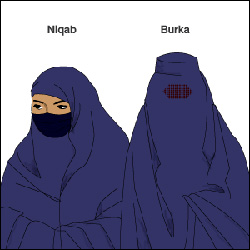Philadelphia's Burqa Crisis
N.B.: The Washington Times title is "When burqas become accessories to crime: Criminals can hide behind Islamic garb" and it contains small differences from this version
Philadelphia, the city where I live, has quietly and unassumedly become the capital of the Western world as regards female Islamic garb as an accessory to crime.

A BBC graphic shows the difference between the niqab and burqa.
|
By my count, the Philadelphia region has witnessed 14 robberies (or attempted robberies) of financial institutions in the past six years in which the thieves relied on an Islamic full-body cover.
They took place in January 2007, June 2007, May 2008, November 2009, October 2010 (two), February 2011, June 2011, December 2011, January 2012, March 2012 (two), and April 2012 (two). The most violent attack took place on May 3, 2008, when Police Sergeant Stephen Liczbinski was killed with an AK-47 in a shoot-out following a successful robbery using burqas; the police then killed one of the criminals.
They took place in January 2007, June 2007, May 2008, November 2009, October 2010 (two), February 2011, June 2011, December 2011, January 2012, March 2012 (two), and April 2012 (two). The most violent attack took place on May 3, 2008, when Police Sergeant Stephen Liczbinski was killed with an AK-47 in a shoot-out following a successful robbery using burqas; the police then killed one of the criminals.
As the Middle East Forum's David J. Rusin points out in his detailed survey of Philadelphia burqa crimes, Muslim garb holds two great advantages over other forms of disguise: First, many full-body covered women walk the streets without criminal intent, thereby inadvertently providing cover for thieves; the more full-body coverings around, the more likely that these will facilitate criminal activity. Second, the very strangeness and aloofness of these garments affords their wearers, including criminals, an extraordinary degree of protection. As in other cases (three purchases of alcohol in Toronto state liquor stores by a 14-year-old boy in a burqa; Muslim women not checked at Canadian airports), clerks so fear being accused of racism or "Islamophobia" that they skip state-mandated procedures, such as requiring niqabis to show their faces and establish their identities.

Video grab of a 14-year-old boy wearing a burqa in an Ontario liquor store.
|
But as banks become harder targets, Islamic garb presents a more general danger to soft targets. For example, in the Philadelphia area, assailants donned Islamic garb to rob a real estate office in 2008 and commit murder at a barber shop in 2012.
Not fatal but equally horrific, was the Jan. 14-15 abduction and rape of a 5-year-old child in Philadelphia. A niqabi signed Nailla Robinson out from the Bryant Elementary School pretending to be her mother taking her to breakfast. Investigators believe the two walked a few blocks to where a man awaited them. Nailla then disappeared for nearly a day and was only found the next morning shivering half-naked in a park by a passerby. Last week, the police arrested Christina Regusters, 19, an daycare center employee with prior contact with Nailla. The fourteen charges against her include kidnapping, rape, aggravated assault, recklessly endangering another person, and criminal conspiracy.

Facebook picture of Christina Regusters, alleged niqabi in the Nailla Robinson case.
|
This survey of Philadelphia's crisis prompts several reflections: First, almost any Western city at any time could have Philadelphia's problems. Second, this is deadly serious issue, involving violent robberies, rapes, and murders. Third, as full-body Islamic covers spread, criminals increasingly depend on them. Fourth, government workers need to surmount their timidity and apply normal procedures even to those wearing full-body covers, even in liquor shops, airports, and elementary schools. Finally, this problem has an obvious solution: ban the niqab and burqa in public places, as the national governments in France and Belgium have recently done.
Mr. Pipes (DanielPipes.org) is president of the Middle East Forum. © 2013 by Daniel Pipes. All rights reserved.
-----
If you found this post interesting or informative, please  it below. Thanks!
it below. Thanks!
 it below. Thanks!
it below. Thanks! 
No comments:
Post a Comment